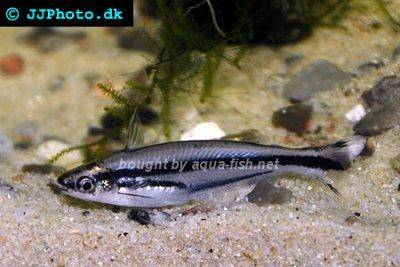Three striped african glass catfish - Pareutropius buffei
Scientific name: Pareutropius buffei
Common name: Three striped african glass catfish
Family: Schilbeidae
Usual size in fish tanks: 8 - 10 cm (3.15 - 3.94 inch)
014
Recommended pH range for the species: 6.6 - 7.6
Recommended water hardness (dGH): 6 - 17°N (107.14 - 303.57ppm)
0°C 32°F30°C 86°F
Recommended temperature: 24 - 28 °C (75.2 - 82.4°F)
The way how these fish reproduce: Spawning
Where the species comes from: Africa
Temperament to its own species: peaceful
Temperament toward other fish species: peaceful
Usual place in the tank: Bottom levels
Origin
Africa; Three striped african glass catfish are to be found in the waterways of Cameroon and Nigeria.
Lifespan
The expected life span for Pareutropius buffei is 8 years.
Short description
It is very important to keep Pareutropius buffei in small groups, if there are only one or two specimens; they will hide away and may refuse to eat. This fish is a very active species but they do prefer to inhabit a planted aquarium. This problem can easily be overcome by confining the planting areas to the rear and sides leaving the front area open, plants that are low in height can be used in these areas without inhibiting the swimming patterns of the fish. They should never be added to an immature set up as unstable water parameters are not ideal, they will stress the fish and affect their long term health. A medium water flow should also be provided but do not make it too strong. A small group of around 6 specimens makes a great addition to a community set up but do not keep these with aggressive tank mates as they are easily intimidated. High water quality must be maintained by performing regular water changes and by using a suitable filtration system.
Food and feeding
Three striped african glass catfish are a very easy fish to feed if they are given the right conditions. Use a quality flake for the staple diet bit it is very important that they are also offered live or frozen foods. They have a great fondness of blood worms, daphnia and Cyclops. Do not be tempted to overfeed the fish, two small meals a day should be ample rather than one large meal in a 24 hour period.
Sexing
They can be difficult to sex unless in a group, the females will have a plumper body shape.
Breeding
Pareutropius buffei can be difficult to breed but not impossible. Provide them with a planted tank and optimum water conditions. Make sure that the pH of the water is acidic, 6.5 to 6.9 is ideal and using aged water from the aquarium to fill the breeding tank will help the parent fish settle quicker. Using an air driven sponge filter will prevent any eggs that have come adrift from being sucked out of the breeding tank. The eggs will be scattered amongst the plants and should attach themselves. Once spawning is complete, remove the parents to prevent them from eating the eggs. After 3 days the fry should hatch and when they are free swimming the can be fed on newly hatched brine shrimp or micro worms.
Spawning may occur through the day but it usually starts early in the morning at around daybreak, dimming the lighting can fool the fish to spawn through the day but not always.
Pictures
Bought by aqua-fish.net from jjphoto.dk.



